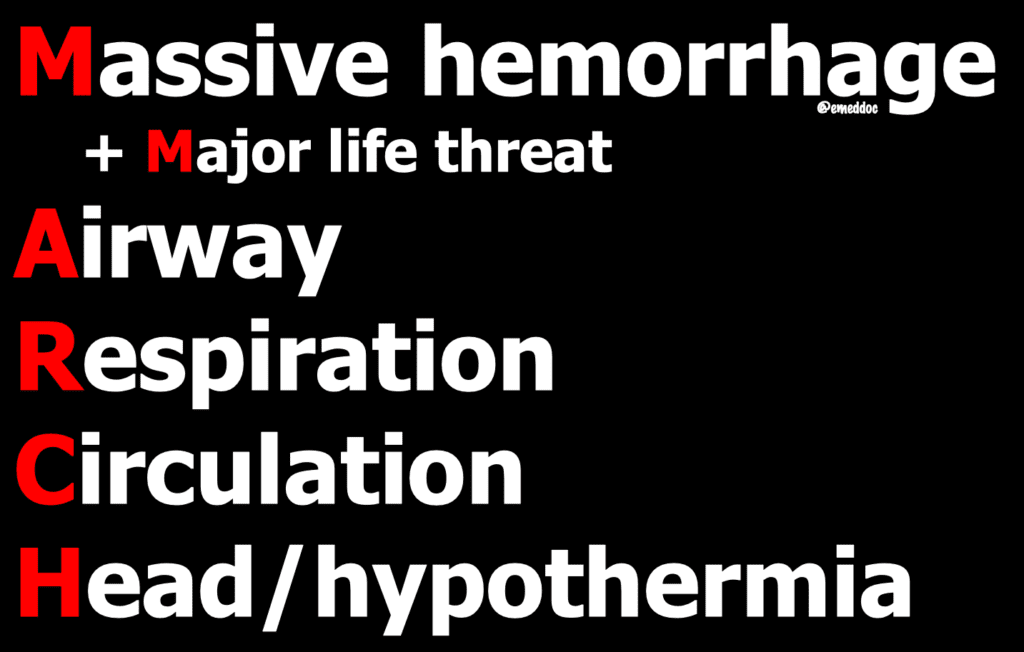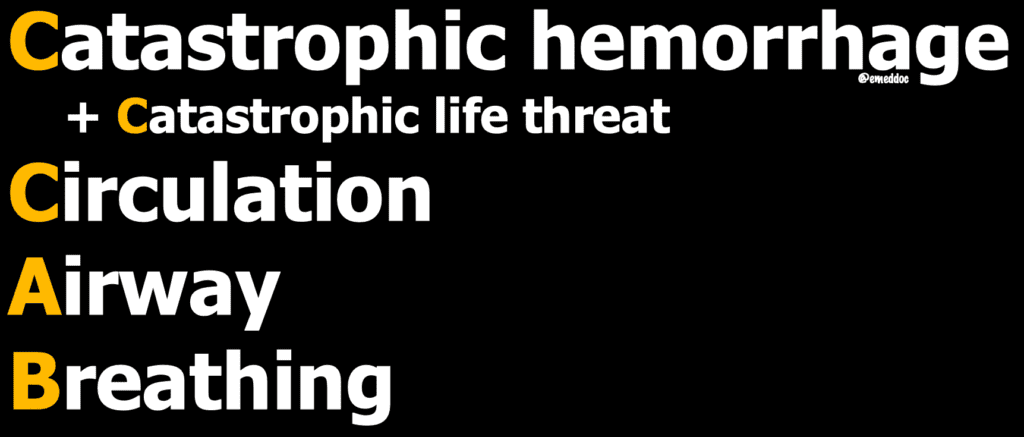
 Airway management as the first priority has been the backbone of resuscitation for years. “Address A first, before moving to B and C,” is what we are taught and what we go on to teach successive generations of learners. For appropriately trained clinical teams, either in- or prehospital, the completion of “A” may well mean performing a rapid sequence intubation (RSI)
Airway management as the first priority has been the backbone of resuscitation for years. “Address A first, before moving to B and C,” is what we are taught and what we go on to teach successive generations of learners. For appropriately trained clinical teams, either in- or prehospital, the completion of “A” may well mean performing a rapid sequence intubation (RSI)
From its inception in the 1970s, there has been continued evolution in how we approach RSI (and airway management in general) in the physiologically threatened patient – this post will focus on the trauma patient. You can revisit some really well-done blogs and podcasts over the last few years that have highlighted various approaches to prevent peri- and post-intubation problems.
Like cardiac arrest.
Imagine this case – a young man has been shot multiple times to the abdomen, and is rushed to your trauma center. His initial vitals show him to be tachycardic, with a systolic blood pressure (SBP) of 64mmHg. He is diaphoretic and severely altered. The team leader asks you to intubate. Your nurse pushes the drugs you requested as soon as IV access is established, and you proceed with an “easy” tube. The airway’s good! Over the next minute though the team notices the monitor reads a heart rate of 138 – but he has no pulses and no recordable blood pressure.
Resuscitation continues, the chest is opened – there is nothing to fix. The heart looks empty, volume is given, and eventually the team gets return of circulation.
It’s a risky business
There are trauma patients who are at or near the end of their physiologic reserve – hypovolemic, acidotic, and struggling to compensate. They are either exsanguinating and/or have a major obstructive pathology (such as a tension pneumothorax or tamponade) and are at very high risk of traumatic arrest from these insults.
Historically there has been concern that by exposing these profoundly shocked patients to poorly planned rapid sequence intubation and subsequent positive pressure ventilation, we may incurring more harm than good.
Sedative medications utilized to induce anesthesia to facilitate intubation all carry the inherent risk of causing hypotension – this is compounded in the hemorrhagic shock state risking cardiac arrest. Paralytic agents, whilst often needed to optimize intubating conditions, causes the patient to become apneic. They lose their compensation for their severe metabolic acidosis until they are ventilated again, worsening the acidosis and risking cardiac arrest. Multiple attempts at intubation increase the risk of hypoxemia, risking cardiac arrest. Finally, the addition of positive pressure ventilation reduces an already compromised venous return to (and by extension cardiac output of) the heart, risking cardiac arrest.
We should strongly consider reordering our approach to resuscitation in the critically ill trauma patient, identifying both overt and covert physiologic threats before proceeding with intubation. When the need for intubation does arise, we need to be optimizing our strategy to ensure both first-pass success and minimal hemodynamic insult.
Bring in the New Order!
If anything good has come out of the recent military conflicts, it is our approach to trauma care. We have learnt the benefit of tourniquets and whole blood, and are applying or studying them in civilian practice.
Another important takeaway should be the re-ordering of our approach to resuscitation. Patients who are truly exsanguinating will likely arrest if you attempt to intubate them first. One of the prototypical wartime injuries was the traumatic amputation leading to massive exsanguination. Over time, their management changed and these patients would always have an extremity tourniquet applied before definitive airway management.
This logically leads to the reordering of resuscitation by shifting the initial focus from airway to managing a major insult like this. The ABC mnemonic can be changed to either (C)CAB (Catastrophic hemorrhage; Circulation; Airway; Breathing) or MARCH (Massive hemorrhage; Airway; Respiration; Circulation; Head/Hypothermia).


In other words, well before you perform an advanced airway maneuver, control the catastrophic hemorrhage AND start replacing lost volume (ideally with what is being lost – blood). Depending on the situation, you can apply a tourniquet to the extremity, pack a wound with hemostatic gauze, bind the pelvis, or hold direct pressure. In centers that have it, resuscitative endovascular balloon occlusion of the aorta (REBOA) may be appropriate as an “internal tourniquet” for non-compressible torso hemorrhage.
The mnemonics can be further modified to include identifying and treating a Catastrophic or Major life threat, adding another C or M. This specifically refers to a major obstructive pathology like a tension pneumothorax.
In parallel to this, you should obtain large bore intravenous or intraosseous access, administer what they are losing – blood – and support the airway with basic airway maneuvers. The latter can include airway opening maneuvers such as a jaw thrust, application of face-mask oxygen, use of adjuncts like an oropharyngeal airway, and, if required, use of appropriately applied bag-valve-mask (BVM) ventilation.
“Well I wasn’t expecting that!”
In the initial minutes of the resuscitation, sometimes it’s obvious that the patient is exsanguinating – you just have to look at the blood pooling on the stretcher and dripping onto the floor.
At other times it can be very challenging to decipher whether this is the case. Again, early intubation without resuscitation in these states of depressed volume or venous return will likely lead to a bad outcome. Hence it is critical to identify covert physiologic threats early.
Clues may be obtained from the initial vital signs in- or prehospital. A systolic blood pressure less than 90mmHg (even in one isolated instant) can be associated with significant mortality in the trauma patient. Using both the blood pressure with the heart rate to calculate a shock index (heart rate/systolic blood pressure) can also be useful. This should normally be 0.5-0.7. As this value exceeds 0.9, the likelihood of post-intubation cardiac arrest increases.
Caveats exist – if your patient is elderly, is taking drugs that can alter heart rate and blood pressure, or has a major neurologic insult (spinal cord injury or severe traumatic brain injury) these numbers may be less reliable. A patient who normally has a systolic pressure of 170mmHg will be hypotensive with a “normal” number.
Using a delta-shock index in these cases may be more useful. This calculates the difference in SI across two time points (e.g. prehospital and ED arrival or two successive readings in the ED). A difference >0.1 can indicate higher mortality or blood product requirement.
For example, an elderly pedestrian is struck by a car. His past history includes hypertension, for which he takes metoprolol and lisinopril. His initial vitals are a heart rate of 85 beats per minute and a systolic blood pressure of 125mmHg. This might seem reassuring though it is important to keep in mind that his baseline systolic pressure may be 140mmHg. The shock index here is 0.68 – again seemingly reassuring. Over the next five minutes, his vitals change to a heart rate of 89 and a systolic of 110mmHg. Again seemingly not worrisome at first glance, but now his shock index is 0.81, and his delta-shock index (0.81-0.68) is 0.13. This patient is actually at significant risk of decline, but this has been masked by his underlying comorbidity and the medications used for it.
Initial point-of-care lab data can also be a strong predictor of mortality. Elevated lactic acid and/or a high base deficit (>6mEq/L) are both recognized as indicative of poor outcomes and should be aggressively addressed. Trending these variables can be useful to identify clinical deterioration or response to resuscitation.
What about immediate clinical signs? These may be all that are available in a rapidly deteriorating patient. Prehospital information is crucial, and is usually the first indicator of severity of physiologic derangement. The presence or absence of central pulses, though varying in reliability, can also be used. My friend from London’s Air Ambulance, Dr. Gareth Davies, describes a constellation of signs and symptoms that identify the truly exsanguinating patient that he terms the “hateful eight” – these are:
- Pallor
- Diaphoresis
- Confusion
- Air hunger
- Brady- or tachycardic
- Low blood pressure
- Low or falling end-tidal CO2
- Collapsed veins
When the exsanguination is not immediately apparent, a combination of these factors can be utilized to identify an imminent though possibly covert physiologic threat. This should prompt a concerted effort to identify and treat the cause before rushing to advanced airway interventions.
Sometimes, you’ve just got to tube…
With the majority of major trauma patients, intubation is not required immediately on patient arrival. There is some time to try to identify the presence of a physiologic threat and initiate resuscitation. Basic airway maneuvers as described above can be used to support the airway while this is done, and then a plan can be made for proceeding to intubation.
The first decision needs to be “do I intubate in the ED or in the operating room?” I would argue that in the presence of some pathologies (for example severe non-compressible torso hemorrhage and pericardial tamponade) it would be more prudent to continue to support the patient’s spontaneous ventilations, expedite transport to the operating room and intubate there where there is now immediate access to the tools needed to provide definitive care.
In other cases, securing the airway rapidly in the ED is advisable. These include severe (often vascular) injuries to the brain, face, or neck which will likely worsen rapidly; severe airway burns; and worsening hypoxia despite basic airway maneuvers. While the identification and management of other physiologic threats occurs in parallel, there are some things you can do to optimize your intubation and ventilation to minimize the risk of decompensation.
Standardizing the approach to intubation in the setting of an ongoing physiologic threat is recommended. Emphasis should be placed on appropriate drug selection and importantly drug dosage. Such a standardized approach allows everyone to share a mental model and minimizes the risk of errors. This standardization can incorporate the use of a checklist, and may also reinforce other interventions to maximize the chance of first-pass success like patient positioning. We continuously review and recently updated our own RSI protocol to reflect these factors.
While the ideal intubation drug does not exist, getting the dose right regardless of agent chosen is extremely important. Where I trained in Baltimore, propofol was the RSI drug of choice because it was very rapidly available without requiring the additional checks with controlled substances. However, the doses used were titrated to the physiology to minimize the risk of post-intubation arrest. Importantly (before everyone reaches for the propofol), the group of clinicians intubating there were all experts at using this particular drug in these shock states.
We chose ketamine for the protocol at my current shop. Ketamine enjoys a relatively hemodynamically favorable profile. However, as this prehospital study showed, even induction with ketamine still has the potential for causing hypotension, especially in those with a high shock index. Therefore, in our protocol we emphasize using a much lower dose (0.5mg/kg) in patients with overt or covert physiologic threats. The same argument of dose adjustment should be made if an alternative agent is chosen for induction. For example, if you choose etomidate, you can reduce the dose to 0.15mg/kg or less.
There is not enough data to support the role of vasopressors in hemorrhagic shock – however, use of bolus-dose or “push dose” vasopressors may be a bridge to allow completion of resuscitation and intubation.
Remember, the transition from negative to positive-pressure ventilation alters thoracic dynamics and by extension the preload and afterload of the right ventricle, predisposing to cardiac arrest in the physiologically-threatened trauma patient. Once a necessary intubation has occurred in these critical patients, your ventilation strategy should also be optimized. It may be reasonable to allow preservation of spontaneous ventilation by utilizing a short-acting paralytic agent during your RSI or adjusting your minute ventilation to account for the patient’s metabolic acidosis if continued paralysis is required. Remember to be careful in the patient with a major traumatic brain injury to prevent hypocapnia. Also, minimize the amount of positive end-expiratory pressure (PEEP) administered – excessive PEEP will further decrease venous return.
The final word
We need to understand that what we do, despite our best intentions can induce harm if we get it wrong. We should continue to evolve our approach to the physiologically-challenged airway, and that includes the critically injured trauma patient. By paying attention to the order of resuscitation, signs and symptoms of covert shock, and the optimization of our intubation and ventilation strategy, we can minimize any secondary injury to our patients.
References:
- Stept WJ, Safar P. Rapid induction-intubation for prevention of gastric-content aspiration. Anesth Analg 1970;49:633-636 PMID: 5534675
- Rezaie S. How to intubate the critically ill like a boss. REBELEM blog May 3, 2019
- Weingart S. Podcast 104 – Laryngoscope as a Murder Weapon Series – Hemodynamic Kills August 5, 2013
- De Jong A, Rolle A, Molinari N et al. Cardiac arrest and mortality related to intubation procedure in critically ill adult patients: A multicenter cohort study. Crit Care Med 2018;46:532-539 PMID: 29261566
- Inaba K, Siboni S, Resnick S et al. Tourniquet use for civilian extremity trauma. J Trauma Acute Care Surg 2015;79:232-237 PMID: 26218691
- Pivalizza EG, Stephens CT, Sridhar S, et al. Whole blood for resuscitation in adult civilian trauma in 2017: A narrative review. Anesth Analg 2018;127:157-162 PMID: 29771715
- Pasquier P, Dubost C, Malgras B et al. The shock index for prehospital identification of patients with early acute coagulopathy and massive bleeding Crit Care 2015;19:152 PMID 25887371
- Petrosoniak A, Hicks C. Resuscitation resequenced: a rational approach to patients with trauma in shock. Emerg Med Clin North Am 2018;36:41-60 PMID: 29132581
- Schellenberg M, Strumwasser A, Grabo D et al. Delta shock indez in the emergency department predicts mortality and need for blood transfusion in trauma patients. Am Surg 2018;83:1059-1062 PMID: 29391095
- Baxter J, Cranfield KR, Clark G et al. Do lactate levels in the emergency department predict outcome in adult trauma patients? A systematic review. J Trauma Acute Care Surg 2016;81:555-566 PMID: 27280943
- Ibrahim I, Chor WP, Chue KM et al. Is arterial base deficit still a useful prognostic marker in trauma A systematic review. Am J Emerg Med 2016;34:626-635 PMID: 26856640
- Hudson AJ, Strandenes G, Bjerkvig CK et al. Airway and ventilation management strategies for hemorrhagic shock: To tube or not to tube, that is the question!. J Trauma Acute Care Surg 2018;84(6S Suppl 1):S77-82 PMID: 29389837
- Hylands M, Toma A, Beaudoin N et al. Early vasopressor use following traumatic injury: a systematic review. BMJ Open 2017;7:e017559 PMID: 29151048
Post Peer Reviewed By: Salim R. Rezaie, MD (Twitter: @srrezaie)
The post First do no Harm: Rethinking Our Approach to Intubation in Trauma appeared first on REBEL EM - Emergency Medicine Blog.
